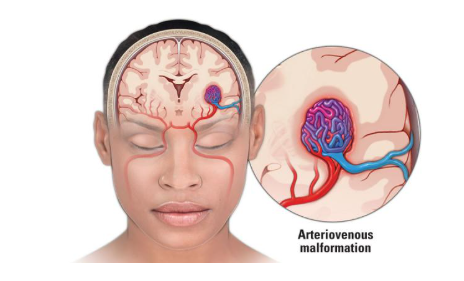By : Geraldus Sigap

The recent death of a marathon runner in Singapore due to sudden brain bleeding has shocked the public. Upon investigation, the cause was identified as Arteriovenous Malformation (AVM), a brain blood vessel abnormality that often goes undetected until it leads to serious complications.
What Is Arteriovenous Malformation (AVM)?
AVM is a congenital abnormality of the vascular system, in which arteries and veins are connected directly without the presence of capillaries. This causes abnormal blood flow and poses a high risk of brain hemorrhage. AVMs can occur in various parts of the body, but those that form in the brain (cerebral AVM) are the most dangerous.
Why Is AVM Dangerous?
AVM often does not cause any symptoms until it suddenly ruptures, leading to brain hemorrhage, which may result in stroke, nerve damage, or even death.
This condition is commonly found in young individuals, including teenagers and young adults, and often goes unnoticed until serious symptoms appear.
Symptoms of Brain AVM to Watch For
AVM may present symptoms similar to other neurological conditions. Common symptoms include:
- Chronic or sudden severe headaches
- Seizures (with or without a history of epilepsy)
- Visual disturbances
- Weakness or numbness on one side of the body
- Sudden speech difficulty or confusion
- Fainting or loss of consciousness
If you or someone close to you experiences these symptoms, consult a neurologist immediately.
Causes and Risk Factors of AVM
The exact cause of AVM is not fully understood. Most cases are congenital (present at birth), but they are not hereditary or genetic.
Main risk factors include:
- Age between 15–40 years
- Male gender (slightly more frequent in males)
- History of head trauma (in some cases)
How Is AVM Detected?
AVM can be identified through a series of brain imaging tests. The typical diagnostic steps include:
- Brain CT Scan / MRI
- Initial tests to view brain structure and detect vascular abnormalities.
- CT Angiography / MRA (Magnetic Resonance Angiography)
- Used to see more detailed blood flow in the brain.
- Digital Subtraction Angiography (DSA)
The gold standard for diagnosing AVM, providing the most accurate view of the size, location, and structure of the malformation.
How Is AVM Treated?
Treatment depends on the size, location, and whether the AVM has already caused bleeding. Options include:
- Observation and Monitoring
- For small, asymptomatic AVMs, doctors may recommend regular imaging and monitoring.
- Embolization
- A minimally invasive procedure to block blood flow to the AVM using a special substance delivered through a catheter.
- Stereotactic Radiosurgery (e.g., Gamma Knife)
- A non-invasive technique using focused radiation beams to gradually destroy the AVM.
- Microsurgical Resection
- Open brain surgery used if the AVM is in a location that is safe to access and remove completely.
Can AVM Be Prevented?
Since AVM is a congenital condition, there is no definitive way to prevent it. However, early detection and appropriate management can prevent serious complications such as brain hemorrhage. Our medical team is ready to help you detect and treat brain aneurysms and AVMs early. Visit RS Abdi Waluyo or book an appointment at 021-3144989.
FAQ
What’s the difference between a rupture brain aneurysm and a stroke?
An aneurysm is a bulging blood vessel that can rupture and cause a hemorrhagic stroke. Stroke can also be caused by blockage (ischemic).
Can a brain aneurysm be completely cured?
Yes, if it’s unruptured and treated promptly with coiling or clipping. If ruptured, the outcome depends on how quickly it is treated.
Can a brain aneurysm be detected early?
Yes. Through CT angiography, MRI, or DSA, especially if risk factors are present.
Does every headache mean an aneurysm?
No. But sudden, severe headaches that feel different from usual should be taken seriously.
Who is at risk for brain aneurysms?
Smokers, people with hypertension, women, those over 40, or those with a family history of aneurysms.
Can aneurysms be prevented?
Not completely, but the risk can be lowered through a healthy lifestyle and blood pressure control.
Resource :
- Arteriovenous Malformation (AVM) | Temple Health [Homepage on the Internet]. [cited 2025 May 7];Available from: https://www.templehealth.org/services/conditions/arteriovenous-malformation
- Arteriovenous Malformations (AVMs) | National Institute of Neurological Disorders and Stroke [Homepage on the Internet]. [cited 2025 May 7];Available from: https://www.ninds.nih.gov/health-information/disorders/arteriovenous-malformations-avms
- Zyck S, Davidson CL, Sampath R. Arteriovenous Malformations of the Central Nervous System [Homepage on the Internet]. In: StatPearls. Treasure Island (FL): StatPearls Publishing, 2025 [cited 2025 May 7]; Available from: http://www.ncbi.nlm.nih.gov/books/NBK531479/
